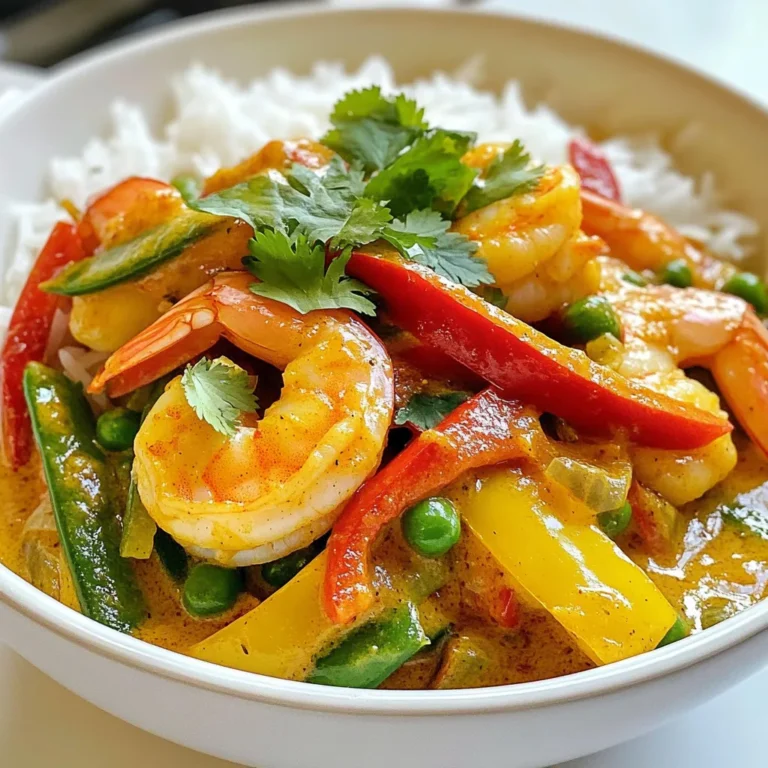WANT TO SAVE THIS RECIPE?
Are you ready to whip up a delicious Coconut Curry Shrimp dish that’s both easy and delightful? This meal is packed with flavor and comes together in no time. With simple ingredients like large shrimp, coconut milk, and red curry paste, you’ll impress your family and friends with minimal effort. Let’s dive into this tasty recipe and transform your next dinner into a culinary delight!
Why I Love This Recipe
- Quick and Easy: This Coconut Curry Shrimp recipe is incredibly simple to make, taking only 30 minutes from prep to table, perfect for busy weeknights.
- Flavor Explosion: The combination of coconut milk, red curry paste, and fresh lime creates a vibrant and mouthwatering sauce that pairs beautifully with shrimp.
- Healthy and Colorful: This dish is packed with vegetables like bell peppers and snap peas, making it not only nutritious but visually appealing too.
- Versatile Serving Options: Serve it over jasmine rice or quinoa, and add lime wedges for an extra zesty kick that enhances the dish’s flavor profile.
Ingredients
Main Ingredients
– 1 pound large shrimp, peeled and deveined
– 1 can (14 oz) coconut milk
– 2 tablespoons red curry paste
– 1 tablespoon olive oil
I love using large shrimp in this dish. They soak up the flavors well. You will need coconut milk for that rich and creamy texture. Red curry paste adds a nice kick and depth to the dish. Olive oil helps sauté the aromatics and veggies perfectly.
Aromatics & Vegetables
– 1 medium onion, finely chopped
– 2 cloves garlic, minced
– 1 tablespoon fresh ginger, grated
– 1 bell pepper, sliced into thin strips
Onions, garlic, and ginger create a wonderful base for the curry. They add warmth and flavor. You can choose red or yellow bell pepper for a splash of color. Snap peas or green beans also add crunch and sweetness.
Seasoning & Garnishing
– 2 tablespoons fish sauce
– 1 tablespoon brown sugar
– Juice of 1 fresh lime
– Fresh cilantro, chopped
Fish sauce gives a savory umami taste. Brown sugar balances the heat of the curry paste. Fresh lime juice brightens the dish and adds zing. Finally, sprinkle chopped cilantro on top for a fresh finish. This blend of ingredients makes the dish truly special!

Step-by-Step Instructions
Preparing the Base
– Heating the oil: Start by pouring 1 tablespoon of olive oil into a large skillet. Heat it over medium heat until it shimmers.
– Sautéing onion, garlic, and ginger: Add 1 finely chopped onion to the skillet. Stir it for 2-3 minutes until it softens. Next, mix in 2 minced garlic cloves and 1 tablespoon of grated ginger. Cook for another minute. You want to smell the lovely aroma.
Building Flavor
– Incorporating curry paste: Now, add 2 tablespoons of red curry paste to the skillet. Stir it well with the onion mix. Let it cook for about 1 minute. This step really brings out the flavors.
– Adding coconut milk: Slowly pour in 1 can of coconut milk. Stir gently to blend everything together. Bring the mixture to a gentle simmer.
Cooking the Shrimp
– Adding vegetables: Toss in 1 sliced bell pepper and 1 cup of snap peas or green beans. Cook for about 5 minutes, stirring often. The veggies should be tender but still crunchy.
– Stirring in shrimp and seasonings: Add 1 pound of peeled and deveined shrimp. Then mix in 2 tablespoons of fish sauce, 1 tablespoon of brown sugar, and the juice of 1 lime. Stir carefully and cook for 3-5 minutes. The shrimp should turn pink and opaque.
– Seasoning to taste: Taste the dish and add salt and pepper as needed. Adjust to make it just right for you.
Tips & Tricks
Cooking Tips
– To avoid rubbery shrimp, do not overcook them. Cook until they turn pink and opaque.
– Sauté aromatics on medium heat. This helps them release their flavors without burning.
Flavor Enhancements
– Adjust spice levels by adding more or less curry paste. Start with a small amount.
– Balance sweet and salty. Add brown sugar for sweetness and fish sauce for saltiness.
Serving Suggestions
– Serve coconut curry shrimp with fluffy jasmine rice or quinoa. They soak up the sauce well.
– For a beautiful dish, garnish with fresh cilantro. Lime wedges on the side add a nice touch.
Pro Tips
- Use Fresh Shrimp: Fresh shrimp will elevate the flavor and texture of your dish. If using frozen shrimp, ensure they are completely thawed and patted dry before cooking.
- Adjust Spice Level: If you prefer a milder curry, start with a smaller amount of red curry paste and gradually increase according to your taste.
- Vegetable Variations: Feel free to add or substitute vegetables like zucchini, broccoli, or carrots for a colorful and nutritious boost.
- Marinate for Flavor: For an extra flavor kick, marinate the shrimp in lime juice and a pinch of salt for about 15 minutes before cooking.

Variations
Ingredient Substitutions
If you want to change the protein, shrimp is not your only choice. Tofu is a great option for a plant-based meal. You can also use chicken for a hearty alternative. Both options work well with coconut milk and curry paste.
When it comes to vegetables, you have many choices. Instead of bell peppers, try zucchini or carrots. Broccoli or mushrooms add great texture too. Just remember to cut them into small pieces for even cooking.
Flavor Variations
Curry paste is key to this dish’s flavor. Red curry paste adds warmth and spice. If you want something different, try green or yellow curry paste. Each type offers a unique taste.
Fresh herbs and spices can elevate your curry. Add basil or mint for a fresh twist. A dash of turmeric can deepen the flavor. Don’t be afraid to experiment with what you have!
Dietary Adjustments
For those avoiding gluten, this recipe is easy to adapt. The main ingredients are naturally gluten-free. Just ensure your curry paste and fish sauce are also gluten-free.
If you’re vegan, simply swap out the shrimp for tofu. Omit the fish sauce and use soy sauce instead. This way, you keep the dish tasty and plant-based. Enjoy the rich flavors without any animal products!
Storage Info
Refrigeration
After enjoying your coconut curry shrimp, store leftovers in an airtight container. Let the dish cool down first. Place the shrimp in the fridge within two hours. Properly stored, it lasts for up to three days. This helps keep the flavors fresh and safe to eat.
Reheating
To reheat, use a skillet over low heat. Add a splash of water or coconut milk to keep it moist. Stir gently and heat until warm. Avoid high heat. High heat can make the shrimp rubbery and tough.
Freezing
You can freeze coconut curry shrimp for later. Use a freezer-safe container and leave some space for expansion. It stays good for up to three months. When ready to eat, thaw it overnight in the fridge. Reheat gently as noted above for the best taste and texture.
FAQs
Can I use frozen shrimp for this recipe?
Yes, you can use frozen shrimp. Just thaw them before cooking. Place the frozen shrimp in cold water for about 15-20 minutes. Drain them well and pat them dry. This helps the shrimp cook evenly and stay tender.
How long does coconut curry shrimp last in the fridge?
Coconut curry shrimp lasts about 3-4 days in the fridge. Store it in an airtight container. Make sure it cools down to room temperature before sealing it. This keeps the flavor fresh and the shrimp safe to eat.
What can I serve with coconut curry shrimp?
You can serve coconut curry shrimp with several sides. Here are some great options:
– Fluffy jasmine rice
– Quinoa for a nutty flavor
– Steamed vegetables for added crunch
– Fresh lime wedges for a zesty touch
These sides help soak up the delicious curry sauce and balance the meal.
Is coconut curry shrimp spicy?
Coconut curry shrimp can be mildly spicy. The red curry paste adds heat but is not overwhelming. You can adjust the spice by using less curry paste. If you like it spicier, add more! Taste as you go to find your perfect level.
This blog post covered how to make a flavorful coconut curry shrimp dish. We explored key ingredients like large shrimp, coconut milk, and red curry paste. I shared step-by-step instructions to create a rich base and cook the shrimp perfectly. You also discovered tips for enhancing flavor and serving ideas. Remember, you can tweak this recipe with different proteins and spices. Enjoy experimenting in your kitchen while creating this tasty meal. Happy cookin
Coconut Curry Shrimp
A delicious and aromatic shrimp dish cooked in a creamy coconut curry sauce with fresh vegetables.
Prep Time 10 minutes mins
Cook Time 20 minutes mins
Total Time 30 minutes mins
Course Main Course
Cuisine Thai
Servings 4
Calories 350 kcal
- 1 pound large shrimp, peeled and deveined
- 1 can coconut milk (14 oz)
- 2 tablespoons red curry paste
- 1 tablespoon olive oil
- 1 medium onion, finely chopped
- 2 cloves garlic, minced
- 1 tablespoon fresh ginger, grated
- 1 bell pepper sliced into thin strips (red or yellow)
- 1 cup snap peas or green beans, trimmed
- 2 tablespoons fish sauce
- 1 tablespoon brown sugar
- 1 juice fresh lime
- to taste salt and pepper
- to garnish fresh cilantro, chopped
In a large skillet or wok, pour in the olive oil and heat it over medium heat until shimmering.
Add the finely chopped onion to the skillet. Sauté for 2-3 minutes, stirring occasionally, until the onion has softened and turned translucent. Mix in the minced garlic and grated ginger, and cook for an additional minute, stirring continuously to prevent burning.
Add the red curry paste to the skillet. Stir it into the cooked vegetables and allow it to cook for about 1 minute.
Slowly pour the coconut milk into the skillet. Stir gently to combine all the ingredients, then bring the mixture to a gentle simmer.
Toss in the sliced bell pepper and snap peas (or green beans) into the simmering sauce. Allow them to cook for about 5 minutes, stirring occasionally.
Add the peeled and deveined shrimp along with the fish sauce, brown sugar, and lime juice to the skillet. Stir carefully, cooking for about 3-5 minutes.
Give the dish a taste, and adjust the seasoning with salt and pepper according to your preference.
Remove the skillet from the heat. Serve the Coconut Curry Shrimp in bowls, garnishing with a generous sprinkle of fresh cilantro.
Serve over jasmine rice or quinoa with lime wedges on the side.
Keyword coconut, curry, quick meal, shrimp
WANT TO SAVE THIS RECIPE?





